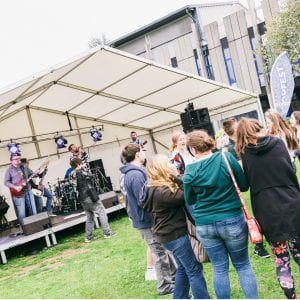 Three years ago I got a phone call from Kathryn Sullivan from NUS HQ, she had heard I was considering taking on another Turn Around Board, having just completed a four year recovery term at Liverpool Hope SU, and asked whether I would consider Marjon as my next project. My first reaction was, Marjon? The one in Plymouth? I had visited Marjon in 2007, and found it charming and friendly. But being based in Liverpool, it didn’t seem the most practical of options available. Kathryn suggested I didn’t make a decision until I spoke to Mick Davies and Daniel Whitby. Before I knew it, I was down a rabbit hole and an exciting new journey in this South West corner had begun.
Three years ago I got a phone call from Kathryn Sullivan from NUS HQ, she had heard I was considering taking on another Turn Around Board, having just completed a four year recovery term at Liverpool Hope SU, and asked whether I would consider Marjon as my next project. My first reaction was, Marjon? The one in Plymouth? I had visited Marjon in 2007, and found it charming and friendly. But being based in Liverpool, it didn’t seem the most practical of options available. Kathryn suggested I didn’t make a decision until I spoke to Mick Davies and Daniel Whitby. Before I knew it, I was down a rabbit hole and an exciting new journey in this South West corner had begun.
Marjon SU, one of the oldest Student Unions in country, I found, was unique in more ways than one. For a small student union, it enjoyed unusual financial and structural stability. Its size was its strength; a place where everyone knew everyone else by name. Unlike many other student unions, where too many students didn’t know the sabbatical team by name, here students knew and trusted their Student Voice leadership. Its resource limitations had given them an innovative edge and simplified its infrastructure. Without the distractions of buildings, commercial enterprises, financial portfolios or large staff teams, they set about the business of dealing with students and voicing their concerns. So what exactly was it that I was here to ‘Turn Around’?
While MSU had instinctively done what all good unions do, it had lost sight of the WHY. The day to day business of ‘getting things done’ and responding to the roller coaster of calendar events on miniscule resources, carried out by the a staff team of 2.2 didn’t really leave a lot of time to spend considering the abstract questions of Mission, Vision & Values or Strategy & Governance. While the competence and commitment of staff had kept the union running for years despite the precarious resource deficit, the risk of the union unravelling was, as the GM, Mick Davies often puts it, is “one May Ball’ away!”.
So we set about the task of developing a strategic plan, one of the ten diagnostic recommendations made by NUS to bring us up to speed. This eighteen month journey spanned planning meetings across three sabbatical teams, and focus groups, stakeholder consultations, away days and planning weeks across the country. At the focus group meetings in the buzzing urban metropolis of Liverpool, Mick and the Sabs spent time exploring and experiencing how other SUs strategized and functioned, meeting with other staff and sabs, and poring over scores of SU strategic plans from across the country. Due to budgetary constraints we decided to do our own research, rather than pay expensive consultation fees to external research firms. So we set about interviewing nearly two hundred students, listening to their experiences, expectations and vision for us. The near one hour interviews gave us a clearer understanding of student experience; what we needed to change and what we needed to retain. In the final planning week spent up in the quiet tip of the Yorkshire Dales, disturbed only by the odd sky lark, we reviewed the student voice research findings, stakeholder reports, institutional feed-back and NUS diagnostics, and put together our strategic plan. It was a week of clarity; not a lot was going to change in the basic day to day running of the student union, but a realm of semantics had shifted in that journey. We knew who we were, and why we did what we did, and more importantly how we were going reify the expectations, values and needs of a couple of thousand students, in a meaningful way.
Listening to near two hundred hours of interview tapes, there were times I nearly lost faith, wondered why I had taken on a research design that required so much time and analysis, in exploring the finer nuances of student experience. There were those days when my train from Liverpool to Devon was delayed near 15 hours, or the many nights spent at the local travel lodge, when I was tired, frustrated and impatient. I often wondered whether someone more local, couldn’t achieve the same outcome. But now, holding this beautiful glossy illustrated strategic booklet in my hand, the voices on those interview tapes I had transcripted and coded sing out like a sublime opus. Each individual voice had a part, was an instrument in shaping where we are going and have shaped a legacy for Marjon students who will take their place in the future. Having achieved all we have achieved in the last two years, I know I’m glad I accepted the invitation, because Marjon offers more than a mere journey of discovery, it offers adventure, belonging and family, and I am glad to have been a part of all of these.
The MSU strategic plan ensures that the SU works towards a clear student mandate and gives its sabbatical officers a clear vision of what the students expect from them as their representatives. It is available here: MSU Strategic Plan

